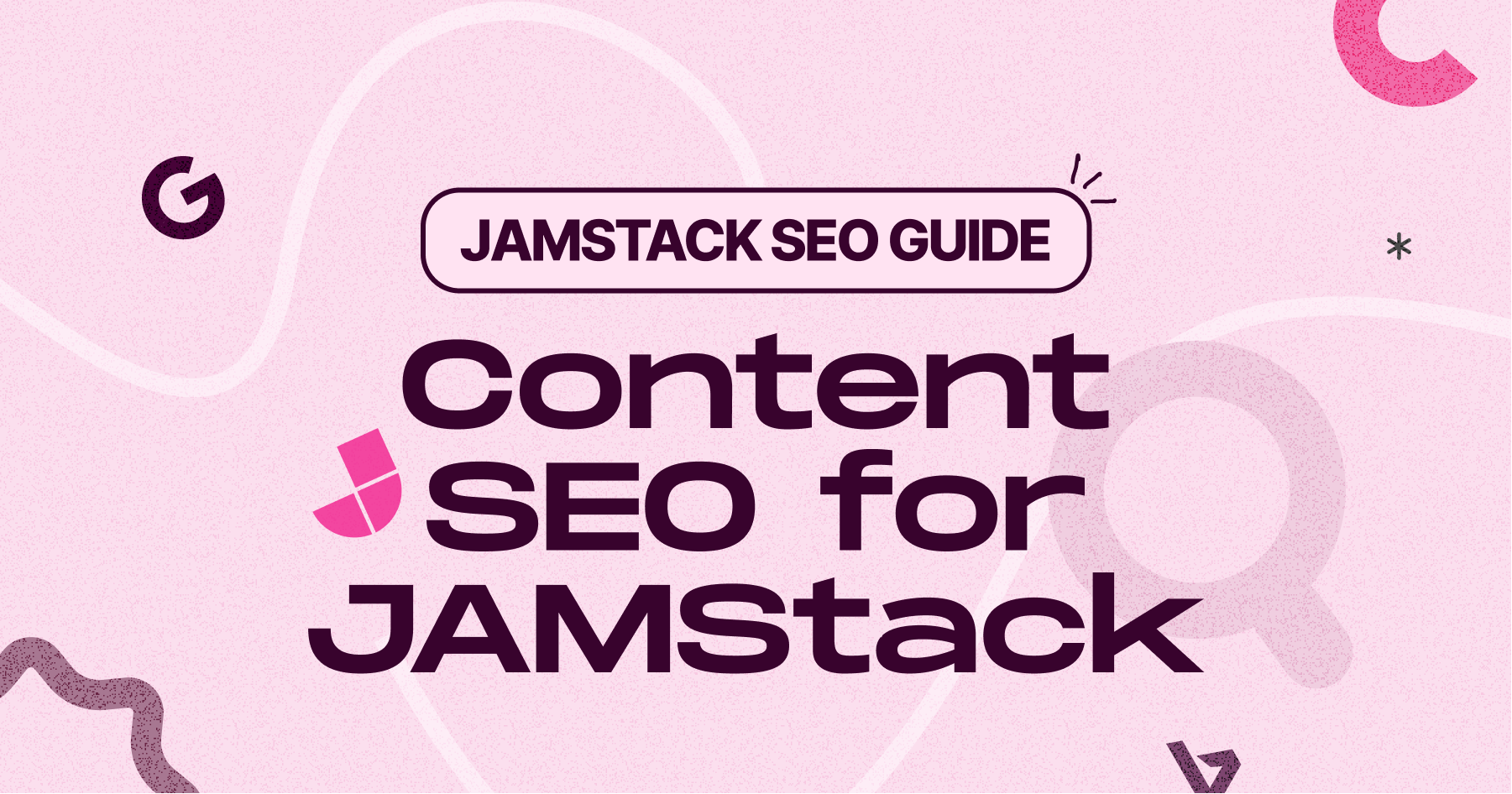April 13, 2023
JAMStack SEO Guide: Content SEO for JAMStack

Nusrat Sarmin

Get ready to take your Jamstack website to the next level! In our last tutorial, we delved into the technical side of SEO, but now it's time to put the spotlight on content SEO for Jamstack sites.
Here are exclusive tips and tricks that will skyrocket your site to the top of search engine rankings. Let’s transform your Jamstack website from dull to dazzling!
What Is Content SEO for Jamstack?
Content SEO for Jamstack sites is the process of optimizing web content for search engines in order to increase visibility, drive traffic, and boost conversions. It helps you create content that is more likely to appear in search engine results pages (SERPs) and encourages users to click through to your website.
Content SEO for Jamstack sites is an important part of ensuring your website ranks well in search engine results pages (SERPs). Content SEO focuses on three main areas:
- Keyword Optimization,
- Link Building,
- User Experience.
In this article, we will discuss each of these topics in more detail and provide some tips for optimizing your Jamstack site's content for SEO success.
When it comes to content SEO, there are two main categories to keep in mind:
- On-page optimization involves various factors such as keyword research, content creation, meta tags, keyword placement, Heading tags, content pruning, and content structure.
- Off-page optimization encompasses various strategies, such as building domain authority, creating backlinks, establishing a brand presence, garnering PR, and generating social shares.
Content SEO for Jamstack: On-Page Optimization
On-page SEO is a process of optimizing individual web pages in order to rank higher and earn more relevant traffic from search engines. In other words, on-page SEO is the process of making sure your website is easily indexed by search engine crawlers and searchers find your site for relevant terms.
The goal of on-Page SEO for Jamstack websites is to create content that both Google and readers find useful so that your website can rank higher in SERPs. This includes optimizing existing content, creating new content, or even updating old content.
Here are some tips on how to optimize your Jamstack website for better SEO performance:
Keyword Research
Keyword research is a crucial first step in content SEO. It involves identifying the keywords and phrases that your target audience is searching for and then optimizing your content around those keywords.
To start with keyword research, you can use tools such as Google Keyword Planner, SEMrush, or Ahrefs. These tools will help you find relevant keywords related to your niche or topic.
Once you have identified the keywords, make sure to include them naturally in your content. Avoid stuffing too many keywords into your content, as this can lead to keyword stuffing penalties from search engines.
Well-researched Content
Creating well-researched content is another important aspect of content SEO. It involves conducting thorough research on your topic and providing valuable information to your readers.
Focus on creating high-quality content that provides value to your users while integrating the keywords naturally throughout the page.
Content Structure
Make sure that your content is well-structured with proper headings, subheadings, and paragraphs that make it easily readable by both search engines and humans alike. You should also include relevant images, videos, charts and other visual elements to make the content more interactive for visitors.
Title with Keywords
One of the key places where keywords should be present is in the title of your content. Keeping relevant keywords in the title of your content is crucial for SEO.
Here are three reasons why keeping keywords in the title is crucial for SEO in a Jamstack architecture:
1. Helps search engines understand the content:
The title tag is one of the most important elements of on-page optimization. Including relevant keywords in the title helps search engines understand what your content is about and rank it accordingly.
2. Improves click-through rates:
When users see a title that includes their search query, they are more likely to click on the link and visit your website. This can lead to increased traffic and engagement on your website.
3. Provides a clear message to users:
A title with relevant keywords gives users a clear idea of what they can expect from your content. This can help attract the right audience to your website, who are more likely to engage and convert.
Use Subheadings
As a content creator, you already know that subheadings help break up your content and make it easier to read. But did you know that subheadings are also critical for SEO? When used correctly, subheadings can help search engines understand the structure of your content, making it more likely to rank higher in search results.
Just like with titles, including relevant keywords in your subheadings can help improve the SEO of your content. However, make sure to use them naturally and don't overuse them.
Unique SEO Title & Meta Descriptions with Keyword
Each page on your website should have a unique SEO title and meta description that accurately reflects its content. This helps search engines understand what the page is about and can improve click-through rates. Use relevant keywords, Keep them concise and compelling.
Search engines typically display only a certain number of characters for titles and meta descriptions, so make sure to keep them concise while still providing enough information about the page.
Use Image with alt tag
Images are a great way to enhance the visual appeal of your content and engage your readers. However, they can also play an important role in SEO for Jamstack sites.
Here's why using images with alt tags is important for SEO:
1. Alt tags provide context: Alt tags are descriptions that you can add to your images to provide context for users who may have trouble viewing the image. This also helps search engines understand what the image is about and can improve its relevance in search results.
2. Alt tags include keywords: Including relevant keywords in your alt tags can help improve the visibility of your page in search results.
3. Images improve the user experience: Using high-quality images that are relevant to your content can improve the user experience and keep readers engaged on your site for longer periods of time.
4. Images increase social sharing: When people share your content on social media, they often include an image from the page. By using high-quality images with alt tags, you increase the chances that people will share your content and drive more traffic to your website.
Use Short URLs and Include Keyword
To optimize your URLs, make sure to use descriptive words that give an idea of what the page is about. Avoid using numbers or random characters in your URLs.
Here's how you can use internal and outbound linking effectively:
1. Use internal links to connect related content: When creating new content, make sure to link to relevant pages on your website that provide additional information or context. This helps search engines understand the structure of your website and can improve the user experience.
2. Use outbound links sparingly: While it's good practice to link to high-quality external sources that provide additional value for your readers, be careful not to overdo it. Too many outbound links can dilute the value of your content and make it seem less trustworthy.
3. Use descriptive anchor text: When creating internal or outbound links, use descriptive anchor text that accurately reflects the content of the linked page. This helps search engines understand what the linked page is about and can improve its relevance in search results.
4. Keep it natural: Don't force internal or outbound links into your content if they don't fit naturally. Instead, focus on creating high-quality content that provides value for your readers and includes relevant internal and external links
Content SEO for Jamstack: Off-Page Optimization
Off-Page Optimization plays a great role in SEO for Jamstack websites. It is important for increasing the reach of your content. This includes activities like link-building, creating and promoting content on social media sites, building relationships with bloggers and influencers, etc. All of these activities help to create brand awareness and boost visibility on search engines.
When optimizing for off-page SEO, there are several key factors to consider:
Content Promotion
Promote your content on various social media sites, blogging sites and other platforms. Additionally, engaging with influencers and bloggers can help spread the word about your website and gain more exposure. It is important to ensure that all of these activities are done strategically to ensure maximum impact.
Link Building
Link building helps to increase visibility on search engines by creating links from other websites to yours. Build backlinks from other sites to yours to improve its credibility with search engine algorithms and boost its rankings in SERPs. This can be done through guest posts on other websites or link exchange programs with other websites in the same niche as yours.
Social Media Activity
Leverage social media platforms to create brand awareness and increase engagement with potential customers. Sharing content on social media platforms like Twitter and Facebook can help boost your off-page SEO efforts. Platforms like Reddit also provide users with an opportunity to network with others in their industry, which can result in more backlinks and higher rankings for your site.
Over to You
The key to success with content SEO for Jamstack websites is to create content that provides value to readers and utilizes effective link-building strategies.
Certainly, content SEO is an important part of optimizing a Jamstack website, as it helps to ensure that your content is visible and relevant to potential customers. While there are many factors to consider when optimizing content, including audience engagement and social media shares, ensuring that your content is high quality and relevant remains a top priority.
Though it may take some time to achieve results with content SEO, the benefits—increased traffic and greater brand awareness – make it well worth the effort. With a well-crafted, comprehensive content strategy and optimization plan in place, you can ensure that your Jamstack site will receive the attention it deserves. As well as you can guarantee that your Jamstack website reaches its full potential.

